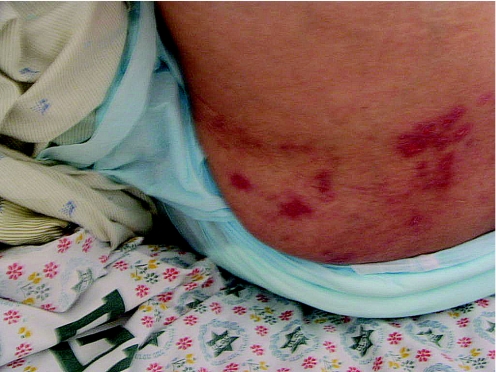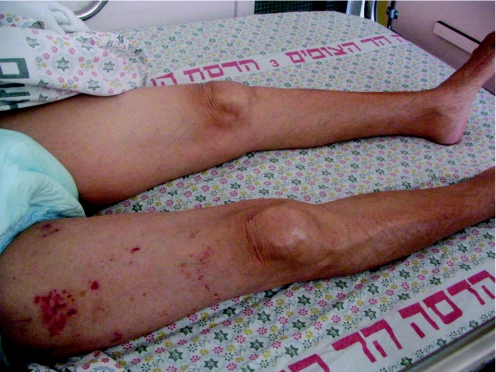Herpes zoster (HZ), caused by reactivation of varicella zoster virus (VZV) from latency in a sensory ganglion, is almost always a condition involving a single dermatome.1,2 Usually it occurs because of an age related decline in cellular immunity or immune compromised conditions. When spreading, it might involve one or two adjacent dermatomes or disseminate systemically (disseminated HZ).3 The simultaneous reactivation of VZV from more than one ganglion is an extremely rare condition.4
Case report
A 64‐year‐old Arab woman was hospitalised with generalised weakness, urinary tract infection and a vesicular eruption on her back and thigh.
Four months previously she had been diagnosed with polymyositis associated antisynthetase syndrome, treated with 60 mg/day prednisone which was gradually tapered down to 20 mg/day by the time of presentation. She had type II diabetes and sustained a left basal ganglia stroke 2 years prior to her presentation.
On physical examination, she was afebrile, alert and fully oriented. She did not have organomegaly or lymphadenopathy without residual deficit from the stroke. She had a vesicular eruption, confined to dermatomes D8 on the left and L4 on the right (figs 1, 2). Laboratory tests, including complete blood count and basic biochemistry panel, were unremarkable, except for a C reactive protein level of 3.7. Diagnosis of HZ in these two dermatomes was established and treatment with intravenous acyclovir 10 mg/kg three times a day was initiated, followed by gradual improvement with crusting of the lesions. No recurrent zosteriform lesions were noticed during a follow‐up period of 2 months.
Figure 1 Zostiform vesicular eruption within the D8 dermatome on the left.
Figure 2 Zostiform vesicular eruption within L4 on the right.
Discussion
Following chicken pox, VZV establishes latent infection in peripheral sensory ganglia. Although the mechanisms of VZV reactivation from latency are unknown, its association with immunological decline suggests that an effective immune system maintains the viral genome in the latently infected cell and prevents viral replication and spread via retrograde axonal flow to the skin.5 Although the latent viral genomes are present in many peripheral sensory ganglia,6 HZ is usually confined not only to a single dermatome but also, and unlike reactivations of herpes simplex virus, to a single episode. Thus it seems that the biological context that supports the phenomenon of reactivation from a single ganglion under systemic immune compromised conditions also requires local factors: these may include the number of viral copies present in the tissue/cell or local trauma such as pressure on the nerve root or ganglion. The context that enables VZV reactivation seems to be so restrictive and dependent on local factors that simultaneous reactivation becomes an extremely rare phenomenon. While in the present case the mechanisms of bilateral VZV reactivation are unknown, it seems that the combined severe immunosuppression provided the required milieu to facilitate such a phenomenon. Whether it occurred independently in two separate ganglia or was caused by viral spread from one ganglion to another remains speculative.
Footnotes
Informed consent was obtained for publication of figs 1 and 2.
References
- 1.Gilden D H, Kleinschmidt‐DeMasters B K, LaGuardia J J.et al Neurologic complications of the reactivation of varicella‐zoster virus. N Engl J Med 2000342635–645. [DOI] [PubMed] [Google Scholar]
- 2.Steiner I. Human herpes viruses latent infection in the nervous system. Immunol Rev 1996152157–173. [DOI] [PubMed] [Google Scholar]
- 3.Kennedy P G E, Grinfeld E, Gow J W. Latent varicella‐zoster virus is located predominantly in neurons in human trigeminal ganglia. Proc Natl Acad Sci USA 1998954658–4662. [DOI] [PMC free article] [PubMed] [Google Scholar]
- 4.Vu A Q, Radonich M A, Heald P W. Herpes zoster in seven disparate dermatomes (zoster multiplex): report of a case and review of the literature. J Am Acad Dermatol 199940868–869. [DOI] [PubMed] [Google Scholar]
- 5.Kennedy P G E, Steiner I. A molecular and cellular model to explain the differences in reactivation from latency by herpes simplex and varicella‐zoster viruses. Neuropathol Appl Neurobiol 199420368–374. [DOI] [PubMed] [Google Scholar]
- 6.Croen K D, Ostrove J M, Dragovic L J.et al Patterns of gene expression and sites of latency in human nerve ganglia are different for varicella‐zoster and herpes simplex viruses. Proc Natl Acad Sci U S A 1988859773–9777. [DOI] [PMC free article] [PubMed] [Google Scholar]




